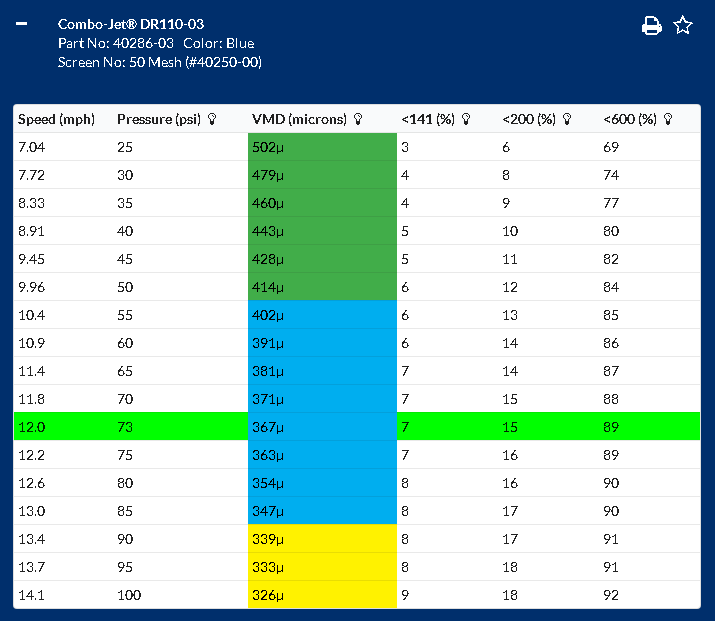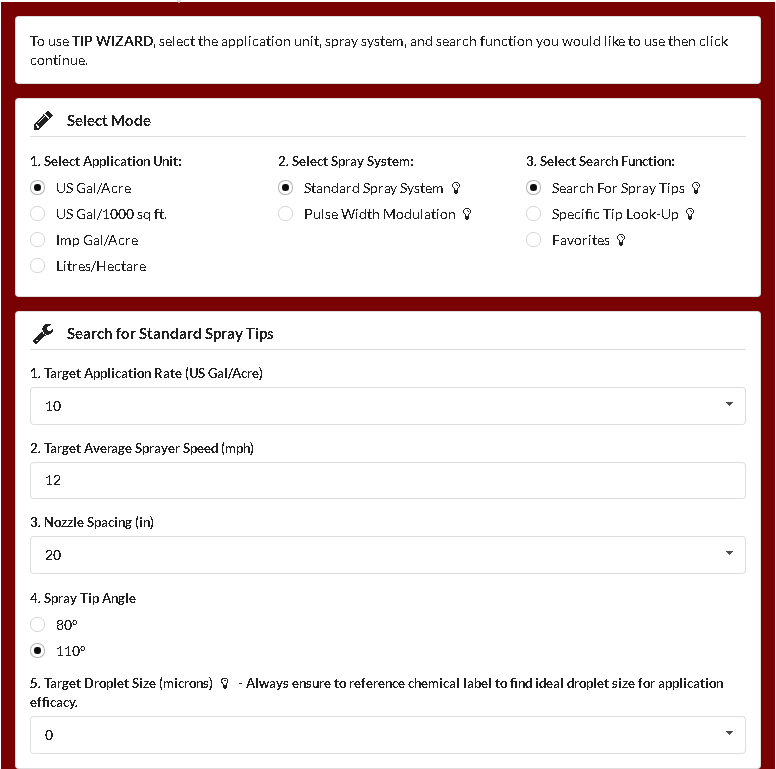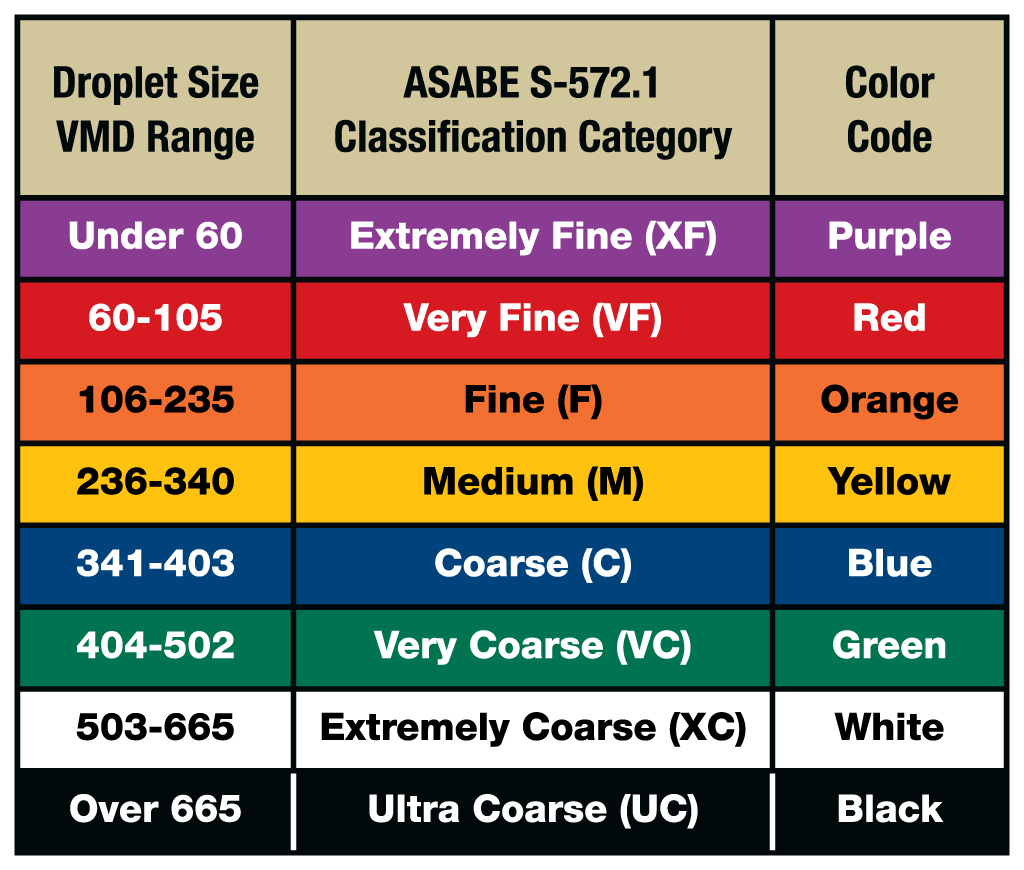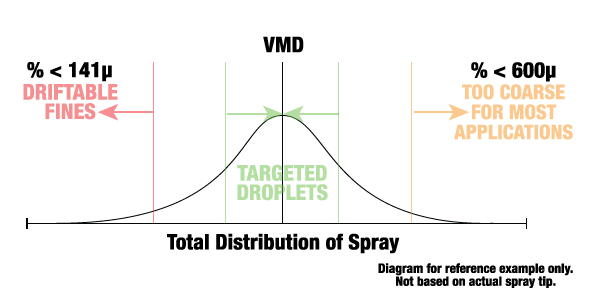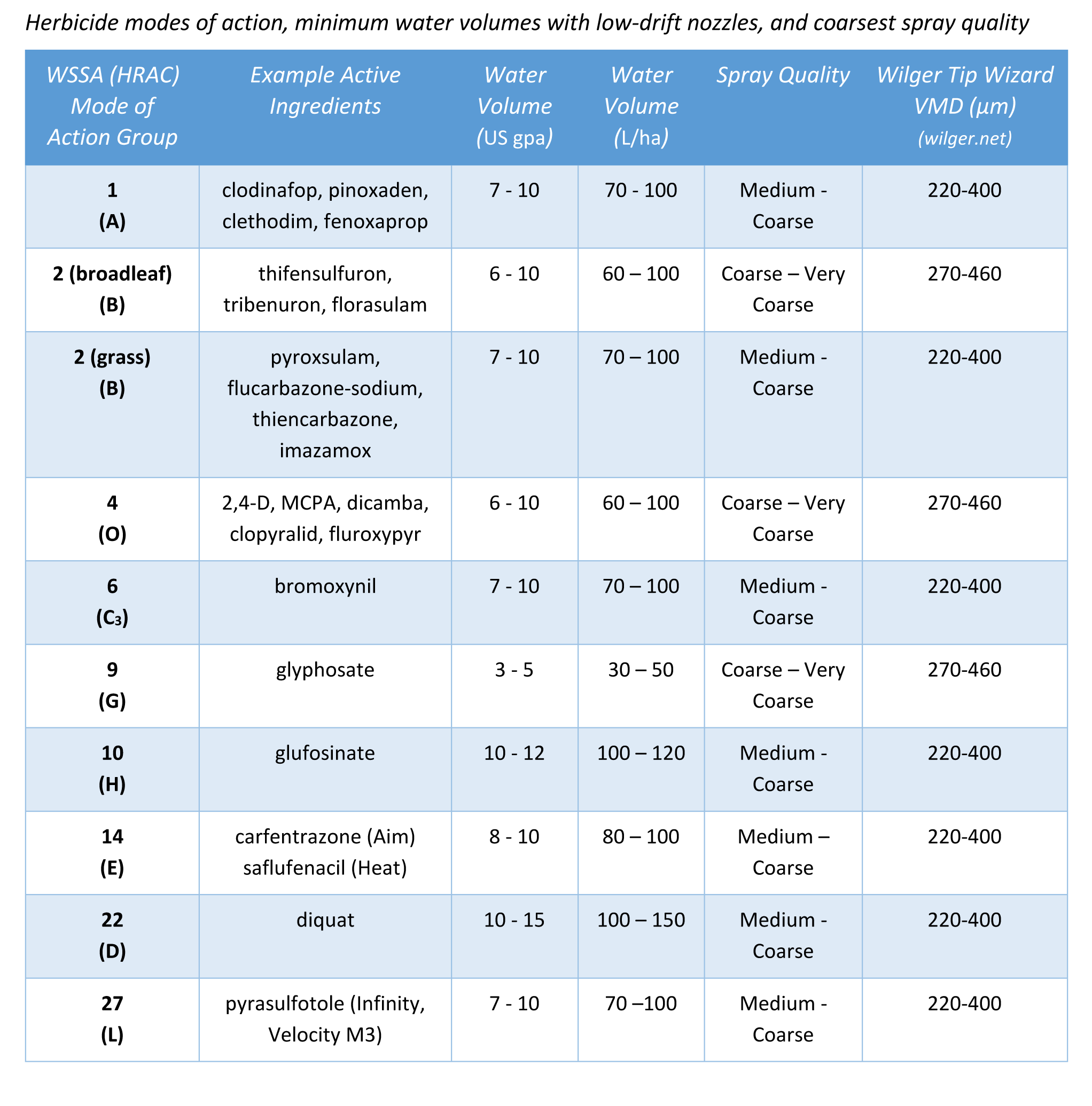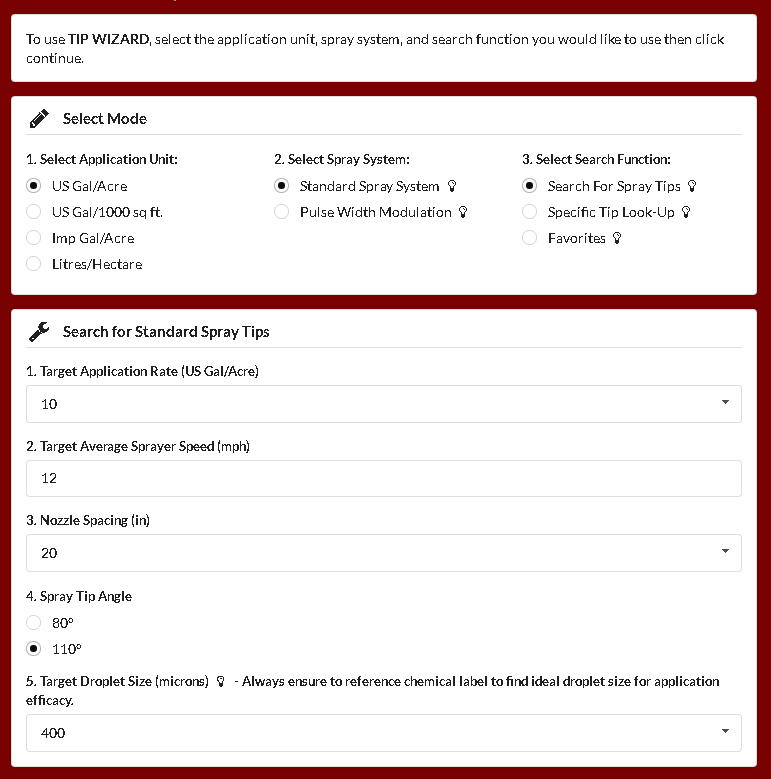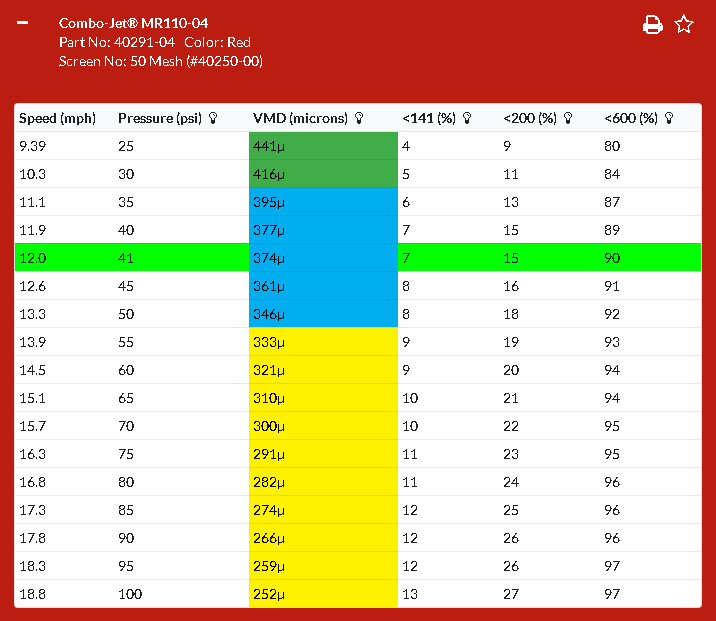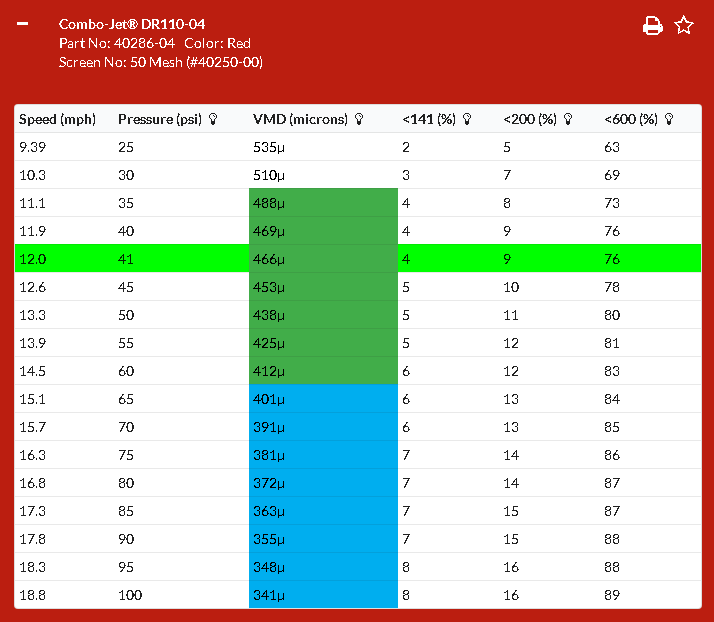Guide to Using Tip Wizard
for Standard Spray Systems

Now that you’ve found Tip Wizard, it may be overwhelming when you first begin using it.
To help explain some of the process that should be added to your tip selection practice, follow through the following guide to learn more about the best way to pick a spray tip that matches your intended spray application.
STEP 1: Sizing Up Your Spray Tips
To “size up” a spray tip means to ensure the flow rate of a spray tip matches your required operating criteria (e.g. Speed/Pressure):
To properly size up a spray tip, some information is required from an operator [click/hover over labels for more information]:
So, now you should have a short list describing your preferred sprayer operation, like the below example:
Required Chemical Application Rate: 10 US Gallons/Acre
Average Sprayer Travel Speed: 12 MPH (down to 9 MPH to turn corners)
Preferred Operating Pressure Range: 50 PSI (so I have enough pressure to slow down to around 9MPH for turning corners)
Tip Spacing: 20″ nozzle/tip spacing
Spray Tip Angle: 110°
Target Droplet Size: BLANK or 0 [Since we are only sizing our tip up first, we can leave this blank or change it to 0. This will show ALL tips within the speed/pressure range.]
With this fairly simple list, we can size a tip up based on the flow rate we require.
[Remember, since we are only sizing the flow rate as the first step, we won’t pay attention to the droplet size or driftable qualities of the spray tip yet.]
When we plug in the desired specifications above into Tip Wizard, it will look like THIS (right).
STEP 1 EXAMPLE [Sizing Up Your Spray Tips]
Tip Wizard will automatically populate a set of results that would try match the input entered.
Search Results are sorted based on size (e.g. -03, which is blue) and then by series (e.g. ER/SR/MR/DR/UR). For each size, there may be up to 5 different series of spray tips shown in the results.
As we are only sizing up the spray tips, we can disregard everything but the speed and pressure listed in the results. [The other information about spray tip series/VMD/Driftable Fines is blurred – the blur will be removed in STEP 2]
A quick note about tip labels and descriptions
A quick note about tip labels and descriptions:
Combo-Jet® spray tips follow an ISO standard for their tip colors. The tip-caps also follow a standard labeling structure that describes everything about the tip in just a few numbers/letters.
For example: MR110-04
‘MR‘ specifies the series of the spray tips. This designates it a ‘mid range’ drift reduction spray tip. Each series of spray tip delivers a different spray quality (within the same flow rate size)
‘110‘ specifies the spray tip angle. 110° is a common spray tip angle for broadcast spraying.
‘-04‘ specifies the flow rate. The last numbers after the hyphen designate the flow rate at 40PSI with water, which is also the standard for the color of the tip-cap as well. -04 would translate to 0.4 US Gallons/Minute, which would be red (as per ISO standard).
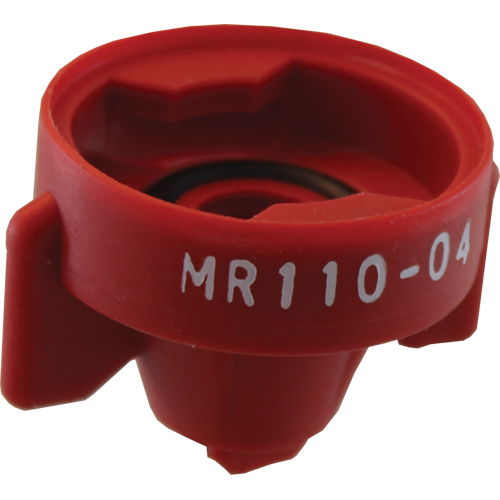
110-03 Size Review
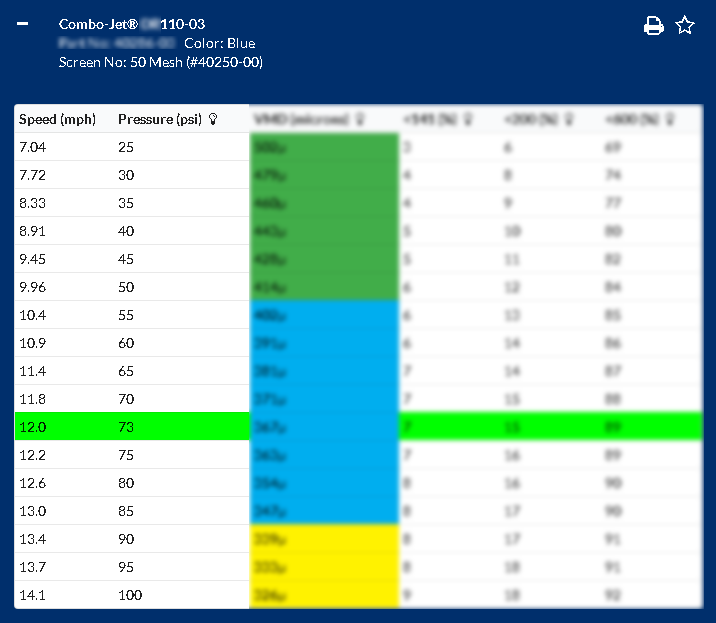
For the 110-03 Tips (Blue color), to maintain a speed of 12.0 MPH, the sprayer would have to maintain ~73 PSI to apply 10 US Gallons/Acre.
The 110-03 allows for a overall speed/pressure range of 7.7MPH @ 30PSI to 13.7MPH @ 90PSI with the -03 tip size.
REVIEW of -03 (Blue) size, for our example application: It means we do over/under applying at our turning speed (~9MPH), and can slow down around the 7.5MPH before we get close to the minimum recommend operating pressure. Overall, at 12MPH, operating at 73PSI is quite high, so that would be a strike against it.
110-04 Size Review
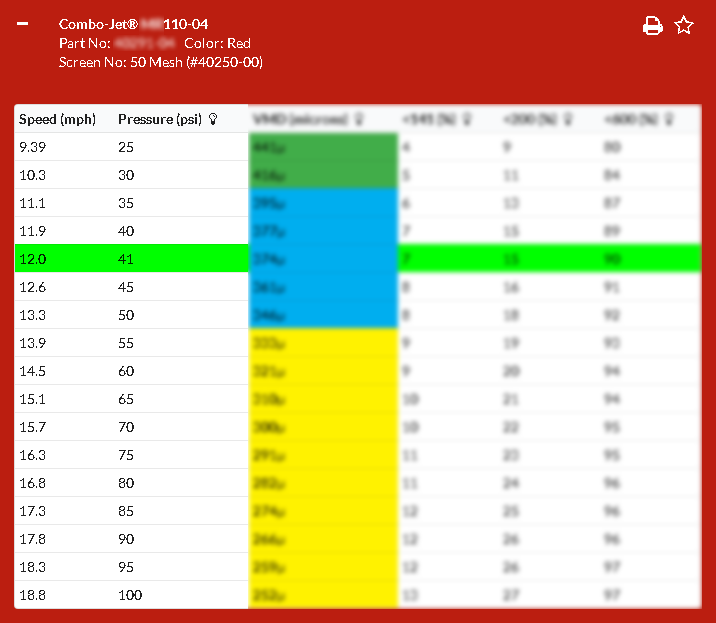
For the 110-04 Tips (Red color), to maintain a speed of 12.0 MPH, the sprayer would have to maintain ~41 PSI to apply 10 US Gallons/Acre.
The 110-04 allows for a overall speed/pressure range of 10.3MPH @ 30PSI to 17.8MPH @ 90PSI with the -04 tip size.
QUICK REVIEW of -04 (Red) size, for our example application: With the -04 size, there may be some loss of coverage due to operating under the recommended operating pressure for the tip at turning speeds. Otherwise, it allows for better overall speed range and pressure over the 12MPH average speed. If speeds can be maintained to be higher than ~10MPH, the -04 size would be a good choice for our intended application.
110-05 Size Review
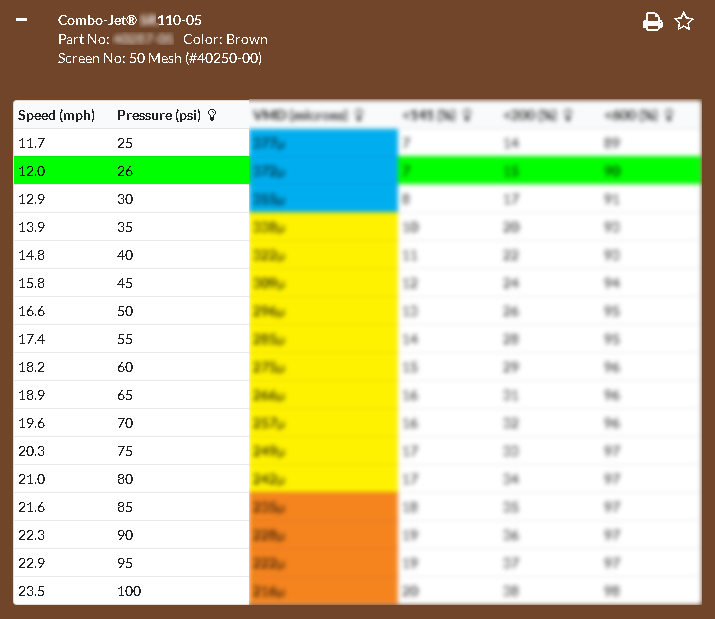
For the 110-05 Tips (Brown), to maintain a speed of 12.0 MPH, the sprayer would have to maintain ~26 PSI to apply 10 US Gallons/Acre.
The 110-05 allows for a overall speed/pressure range of 12.0MPH @ 26PSI to 22.3MPH @ 90PSI with the -05 tip size.
REVIEW of -05 (Brown) size, for our example application:
Overall, as the -05 is starting our 10 US Gallon/Acre application at 26 PSI, we would have to go considerably faster to maintain effective pressure/speed range. In general, the -05 size would not work for our required application.
Results Overview
Why you might choose the -04 size:
The -04 suites the average speed best, with the only downside that at lower speeds (<10MPH) may result in spottier coverage.
Why you might not choose the -03 size:
The -03 size gives the best overall speed range to slow down, but would not allow for much faster speeds, and relies on operating at higher pressures at the average speed.
Why NOT to choose the -05 size:
The -05 was too large of a spray tip, and would not suite the needs of the application.
STEP 2: Match Ideal Spray Quality To Your Spray Tip Selection
Applying a chemical with a spray quality or droplet size that is tailored to the targeted application is critical and is the best practice for any spray application.
Spraying outside of the chemical label requirements or recommendations can lead to poor chemical efficacy and coverage, as well as excessive off-target drift. Each of those can result in avoidable consequences ranging from crop damage, environmental impact, as well as legal penalty.
Where to Find your "Ideal Spray Quality" or "Targeted Droplet Size"
Best Resource: Chemical Label & Information from Manufacturer
At every opportunity, first reference the chemical label to find the application recommendation (or requirements) as it relates to the physical droplet size to target with an application. This information may be shared in a few different ways including [but not limited to]: listing a VMD (volumetric median diameter) or Dv0.5 in microns, an ideal spray quality (e.g. ASABE COARSE droplet size), or even having a list of certified/allowed spray tips and their associated pressure ranges.
If you do not find a reference for an ideal droplet size in the chemical label, request the information from your chemical company representative, as they may have specific information about your intended application.
If possible, request a specific ideal droplet size to target in microns, as it will allow you to tailor your tip selection as close as possible to the very best application result.
Example Label Reference; this is a reference for a example ONLY, and should NOT be used as a general guide for any chemical:
Application Information:
- Water Volume:
- Ground: 20 to 40L per acre.
- Aerial: 12 to 20L per acre. Consult label for buffer zones.
- Nozzles and Pressure:
- Maximum 30 to 40 PSI (200 to 275 kPa) with conventional flat fan nozzles. Low drift nozzles may require higher pressures for proper performance. Use nozzles and pressure designed to deliver proper coverage with ASABE S572.1 coarse droplets.
What is an ASABE S572.1 Coarse Droplet?
The American Society of Agricultural and Biological Engineers developed a standard that isolates the classification of droplet sizes into a number of category ranges. These ranges (from Extremely fine to Ultra Coarse) reference the different spray qualities, based on their respective distribution of droplet size.
The full standard may be purchased from the ASABE here.
Wilger tries to provide even further information with the ASABE standard. From testing tips at different pressures (with water at 70°F), Wilger provides a VMD (in microns) that shows the size of the median in a droplet spectrum of a tip at a certain pressure.
What is the VMD, and why does it make a difference?
The Volumetric Median Diameter (VMD) or Dv0.5 is referenced as a middle point of a droplet distribution from a spray tip at a given pressure, so half of the volume would be made up of droplets smaller than the VMD, and half of the volume would be made up of droplets larger than the VMD.
If you rely on using the droplet size category only (e.g. COARSE), then you do not know if you are at the top, middle or bottom end of that droplet size category range. Whereas, using a micron size of 350 microns, you know you are applying on the lowest of the ‘coarse’ spectra.
For a cross-reference of what these category ranges and droplet size (in microns), see the ASABE S572.1 and VMD chart.
General Guides & Resources for Mode of Action and Chemical Type
If the chemical label does not specify a droplet size or droplet category, it can be helpful to refer to general guidelines for the different types of chemicals as well as their respective modes of application and targets. ALWAYS check with chemical label thoroughly, as well as alternative resources direct from the chemical manufacturer prior to consulting guidelines.
For an example, find the below chart, differentiation a rough guideline of what kind of applications might warrant certain droplet sizes or categories.
Educational Resources
AGRONOMISTS
Professional agronomists can also provide supplementary information tailored to the best way to target and manage specific pests/weeds.
WEED EXTENSION STUDIES
Many Universities that have emphasis on agricultural studies often have weed extension programs that can be good resources when trying to improve an application to better target a specific weed/issue.
PROFESSIONAL AND EDUCATIONAL RESOURCES
As another guide to general modes of action for different herbicides, there are also reference charts, referring to each mode of action chemical group, as well as their intended targets.
One of such examples is shown by the team at Sprayers101.com, a useful website for reference information and education about improving spraying practices. Visit Sprayers101.com to see more information. [Website content developed by Dr. Jason Deveau and Dr. Tom Wolf]
STEP 2 EXAMPLE [Matching Ideal Spray Quality To Your Spray Tip Selection]
We are applying a systemic herbicide for broad leaf weed control. For this example, we are using the chemical shown in the example chemical label (below).
Since there is more drift sensitivity with systemic herbicides, we’d want to stick to closer to the upper range of the the coarse spectrum, but still be aware that the coarser we go, the less coverage we will get. In the event that the chemical label doesn’t specify a specific droplet size range to target, we will select a VMD of ~400 microns. This will provide large droplets which are less prone to drift, but should still result in satisfactory coverage with a systemic herbicide controlling broad leaf weeds.
We are applying a systemic herbicide for broad leaf weed control. For this example, we are using the chemical shown in the example chemical label (below).
Since there is more drift sensitivity with systemic herbicides, we’d want to stick to closer to the upper range of the the coarse spectrum, but still be aware that the coarser we go, the less coverage we will get. In the event that the chemical label doesn’t specify a specific droplet size range to target, we will select a VMD of ~400 microns. This will provide large droplets which are less prone to drift, but should still result in satisfactory coverage with a systemic herbicide controlling broad leaf weeds.
Figuring out the Tip Wizard Results
In STEP 1: Sizing Up Your Spray Tip, we decided that an 110-04 tip size would suite our application best. Even though in the Tip Wizard results, it will show other tip sizes/series, we will only focus on the 110-04 size.
Since the MR110-04 shows in the results first (for the -04 sized tips), we will review it first.
From left to right, we will describe the benefits/drawbacks of each column.
MR110-04 Result Review
SPEED (MPH): Reviewed in STEP 1. GOOD.
PRESSURE (PSI): Reviewed in STEP 1. GOOD.
VMD (microns): 374µ @ ~41PSI. GREAT. We were targeting for an ideal droplet size of 400 microns (µ), which is VERY close to where our typical application at 12MPH/~41PSI would be. [For reference, 100 microns is equivalent to the width of a human hair.]
% < 141µ (%): 7%. GOOD. As a general rule, we typically want to keep this number as LOW as possible, while maintaining the % <600µ figure as HIGH as possible.
Ultimately, droplets that are smaller than 141µ have a high propensity to drift, and are typically referred to as driftable fines. As we are applying a systemic herbicide, we want to keep this minimized. Given the example application, it is a reasonable figure for drift. For areas that have greater drift sensitivity (e.g. headlands, near neighboring fields, waterways, etc.), the operator would slow down to maintain a consistent rate at a lower pressure, reducing driftable fines.
% < 200 µ (%): 15%. GOOD. Droplets smaller than 200 microns have less propensity to drift, but in less than ideal conditions will become drift-prone. Consider the % < 200µ as driftable fines with a safety bubble. It provides a further glimpse of where the physical droplet spectrum curve would sit when it comes to smaller droplets.
% < 600µ (%): 90%. EXCELLENT. As a general rule, we typically want to keep this number as HIGH as possible, while maintaining the % <141µ figure as LOW as possible.
We want to minimize droplets larger than 600 microns as they typically provide less chemical efficacy than smaller, more meaningful droplets [e.g. smaller than 600 microns, but still larger than ~200 microns]. (Exceptions do apply based on different applications) As a frame of reference, anything over 80% would typically be satisfactory for a systemic herbicide targeting coarse or greater droplet size. For contact herbicides, insecticides, or fungicides, it is typically ideal to try maintain 90%+.
DR110-04 Result Review
The DR110-04 was the second -04 size that showed up in Tip Wizard, as it was able to closely match our intended application.
SPEED (MPH): Reviewed in STEP 1. GOOD.
PRESSURE (PSI): Reviewed in STEP 1. GOOD.
VMD (microns): 466µ @ ~41PSI. TOO COARSE. We were targeting for an ideal droplet size of 400 microns (µ), which is significantly smaller than 466µ. [Remember, the VMD is the middle point of the distribution of droplets, so the whole droplet curve shifted ~66 microns coarser]
% < 141µ (%): 4%. EXCELLENT. 4% driftable fines is very low. That being said, it will come at a cost of coverage, so reviewing the % < 600µ is necessary.
% < 200 µ (%): 9%. GREAT. Very low driftable fines with a safety bubble.
% < 600µ (%): 76%. LESS THAN IDEAL. The large percentage of overly-large droplets will produce less coverage. There will be less drift, but significantly coverage.
Results Overview
Based on the review for the MR110-04 and the DR110-04, it is fairly clear that the MR110-04 would be the most suitable for the application.
The DR110-04 would be useful for the same 10 US GPA application at 12MPH for fields that are a lot more drift sensitive, but for our specific application and needs, it is a bit too coarse overall.

What to do if you want more options?
Since Wilger manufacturers 5 different series of spray tips for each tip size, you can often adjust your application criteria (e.g. speed/pressure/etc.) in Tip Wizard and see if a smaller size of tip would fit your application (but the series of spray tip will likely differ) Often, this will mean running higher than typical pressures (in the event of a smaller size of tip) to maintain the same application.
For example, reference the DR110-03 Tip Wizard result for the same application. It effectively means we have to spray at 73PSI to maintain a ~400VMD. It also means we would have a better ability to go slower, but not much faster. In this example, we could go to a smaller tip size (to -03 from an -04) and to a coarser series (DR from an MR) and get a similar result at a different operating speed/pressure range.
